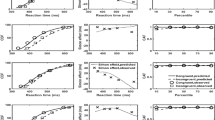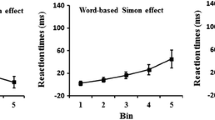Abstract
A left or right keypress response to a relevant stimulus attribute (e.g., color) is faster when irrelevant left or right stimulus-location information corresponds with the correct response than when it does not. This phenomenon, known as the Simon effect, is obtained not only for physical locations, but also location words “left” and “right” and left- or right-pointing arrows. However, these location-, word-, and arrow-based Simon effects show different patterns in the reaction-time (RT) distributions, as evident in delta plots. In the present study, we employed procedures, analysis of survival curves and divergence point analysis, which have not previously been applied to the Simon effect, to investigate differences in time course of these various Simon effects in more detail. Also, we examined whether the diffusion model for conflict tasks (DMC), which assumes that automatic activation of task-irrelevant information occurs in a pulse-like function, can capture not only features of the RT distributions for the location-based Simon effect, to which it has been fit previously, but also features of the word- and arrow-based Simon effects, to which it has not. Results showed different survival curves and earliest, maximum, and latest divergence points for the three Simon effects, but DMC was able to capture the basic features of the RT distributions reflected by delta plot and survival curves for all effects. The results imply that the location-, word-, and arrow-based Simon effects have shared mechanisms, although they have different RT distributions.






Similar content being viewed by others
References
Ando, E., Matsuki, K., Sheridan, H., & Jared, D. (2015). The locus of Katakana-English masked phonological priming effects. Bilingualism: Language and Cognition,18, 101–117.
Ansorge, U., & Wühr, P. (2004). A response-discrimination account of the Simon effect. Journal of Experimental Psychology: Human Perception and Performance,30, 365–377.
Baroni, G., Pellicano, A., Lugli, L., Nicoletti, R., & Proctor, R. W. (2012). Influence of temporal overlap on time course of the Simon effect. Experimental Psychology,59, 88–98.
Burle, B., van den Wildenberg, W. P. M., & Ridderinkhof, K. R. (2005). Dynamics of facilitation and interference in cue-priming and Simon tasks. European Journal of Cognitive Psychology, 17, 619–641.
De Jong, R., Liang, C.-C., & Lauber, E. (1994). Conditional and unconditional automaticity: A dual-process model of effects of spatial stimulus–response correspondence. Journal of Experimental Psychology: Human Perception and Performance,20, 731–750.
Efron, B., & Tibshirani, R. J. (1994). An introduction to the bootstrap. Boca Raton, FL: Chapman & Hall.
Ellinghaus, R., Karlbauer, M., Bausenhart, K. M., & Ulrich, R. (2018). On the time-course of automatic response activation in the Simon task. Psychological Research,82, 734–743.
Geisser, S., & Greenhouse, S. W. (1958). An extension of box’s results on the use of the F distribution in multivariate analysis. The Annals of Mathematical Statistics,29, 885–891.
Hoedemaker, R. S., & Gordon, P. C. (2017). The onset and time course of semantic priming during rapid recognition of visual words. Journal of Experimental Psychology: Human Perception and Performance,43, 881–902.
Hommel, B. (1993). The relationship between stimulus processing and response selection in the Simon task: Evidence for a temporal overlap. Psychological Research,55, 280–290.
Hommel, B. (1994). Spontaneous decay of response-code activation. Psychological Research,56, 261–268.
Khalid, S., & Ansorge, U. (2013). The simon effect of spatial words in eye movements: Comparison of vertical and horizontal effects and of eye and finger responses. Vision Research, 86, 6–14.
Kornblum, S., Hasbroucq, T., & Osman, A. (1990). Dimensional overlap: Cognitive basis for stimulus-response compatibility–a model and taxonomy. Psychological Review, 97, 253–270.
Logan, G. (1980). Attention and automaticity in Stroop and priming tasks: Theory and data. Cognitive Psychology,12, 523–553.
Lu, C.-H., & Proctor, R. W. (1995). The influence of irrelevant location information on performance: A review of the Simon and spatial Stroop effects. Psychonomic Bulletin and Review,2, 174–207.
Lu, C.-H., & Proctor, R. W. (2001). Influence of irrelevant information on human performance: Effects of S–R association strength and relative timing. Quarterly Journal of Experimental Psychology,54, 95–136.
Luo, C., & Proctor, R. W. (2017). How different location modes influence responses in a Simon-like task. Psychological Research,81, 1125–1134.
Luo, C., & Proctor, R. W. (2018a). How different direct association routes influence the indirect route in the same Simon-like task. Psychological Research. https://doi.org/10.1007/s00426-018-1024-5.
Luo, C., & Proctor, R. W. (2018b). The location-, word-, and arrow-based Simon effects: An ex-Gaussian analysis. Memory and Cognition,46, 497–506.
Miles, J. D., & Proctor, R. W. (2012). Correlations between spatial compatibility effects: Are arrows more like locations or words? Psychological Research,76, 777–791.
Modern Chinese Frequency Dictionary. (1985). Beijing, People’s Republic of China: Beijing Language Institute Press.
Nelder, B. J. A., & Mead, R. (1964). A simplex method for function minimization. The Computer Journal, 7, 308–313.
Pellicano, A., Lugli, L., Baroni, G., & Nicoletti, R. (2009). The Simon effect with conventional signals: A time-course analysis. Experimental Psychology,56, 219–227.
Pratte, M. S., Rouder, J. N., Morey, R. D., & Feng, C. (2010). Exploring the differences in distributional properties between Stroop and Simon effects using delta plots. Attention, Perception, and Psychophysics,72, 2013–2025.
Proctor, R. W., Marble, J. G., & Vu, K.-P. L. (2000). Mixing incompatibly mapped location-relevant trials with location-irrelevant trials: Effects of stimulus mode on the reverse Simon effect. Psychological Research,64, 11–24.
Proctor, R. W., Miles, J. D., & Baroni, G. (2011). Reaction time distribution analysis of spatial correspondence effects. Psychonomic Bulletin and Review,18, 242–266.
Proctor, R. W., Yamaguchi, M., Zhang, Y., & Vu, K.-P. L. (2009). Influence of visual stimulus mode on transfer of acquired spatial associations. Journal of Experimental Psychology: Learning, Memory, and Cognition,35, 434–445.
Ratcliff, R. (1978). A theory of memory retrieval. Psychological Review,85, 59–108.
Ratcliff, R., & Smith, P. L. (2004). A comparison of sequential sampling models for two-choice reaction time. Psychological Review,111, 333–367.
Ratcliff, R., Smith, P. L., Brown, S. D., & McKoon, G. (2016). Diffusion decision model: Current issues and history. Trends in Cognitive Sciences,20, 260–281.
Reingold, E. M., Reichle, E. D., Glaholt, M. G., & Sheridan, H. (2012). Direct lexical control of eye movements in reading: Evidence from a survival analysis of fixation durations. Cognitive Psychology,65, 177–206.
Reingold, E. M., & Sheridan, H. (2018). On using distributional analysis techniques for determining the onset of the influence of experimental variables. The Quarterly Journal of Experimental Psychology, 71, 260–271.
Reingold, E. M., & Sheridan, H. (2014). Estimating the divergence point: A novel distributional analysis procedure for determining the onset of the influence of experimental variables. Frontiers in Psychology,5, 1–10.
Reingold, E. M., & Sheridan, H. (2018). On using distributional analysis techniques for determining the onset of the influence of experimental variables. Quarterly Journal of Experimental Psychology,71, 260–271.
Scerrati, E., Lugli, L., Nicoletti, R., & Umiltà, C. (2017). Comparing Stroop-like and Simon effects on perceptual features. Scientific Reports,7, 17815.
Schwarz, W., & Miller, J. (2012). Response time models of delta plots with negative-going slopes. Psychonomic Bulletin and Review,19, 555–574.
Servant, M., White, C., Montagnini, A., & Burle, B. (2016). Linking theoretical decision-making mechanisms in the Simon task with electrophysiological data: A model-based neuroscience study in humans. Journal of Cognitive Neuroscience,28, 1501–1521.
Simon, J. R. (1990). The effects of an irrelevant directional cue on human information processing. In R. W. Proctor & T. G. Reeve (Eds.), Stimulus–response compatibility: An integrated perspective (pp. 31–86). Amsterdam: North-Holland.
Ulrich, R., Schröter, H., Leuthold, H., & Birngruber, T. (2015). Automatic and controlled stimulus processing in conflict tasks: Superimposed diffusion processes and delta functions. Cognitive Psychology,78, 148–174.
Ulrich, R., Schröter, H., Leuthold, H., & Birngruber, T. (2016). Corrigendum to automatic and controlled stimulus processing in conflict tasks: Superimposed diffusion processes and delta functions [Cogn. Psychol. 78 (2015) 148–174]. Cognitive Psychology, 91, 150.
Umiltà, C., & Nicoletti, R. (1990). Spatial stimulus–response compatibility. In R. W. Proctor & T. G. Reeve (Eds.), Stimulus–response compatibility: An integrated perspective (pp. 89–143). Amsterdam: North-Holland.
Wascher, E., Schatz, U., Kuder, T., & Verleger, R. (2001). Validity and boundary conditions of automatic response activation in the Simon task. Journal of Experimental Psychology: Human Perception and Performance,27, 731–751.
Wiegand, K., & Wascher, E. (2005). Dynamic aspects of stimulus–response correspondence: Evidence for two mechanisms involved in the Simon effect. Journal of Experimental Psychology: Human Perception and Performance,31, 453–464.
Wiegand, K., & Wascher, E. (2007). The Simon effect for vertical S–R relations: Changing the mechanism by randomly varying the S–R mapping rule? Psychological Research,71, 219–233.
Yamaguchi, M., & Proctor, R. W. (2012). Multidimensional vector model of stimulus–response compatibility. Psychological Review,119, 272–303.
Zorzi, M., & Umiltà, C. (1995). A computational model of the Simon effect. Psychological Research,58, 193–205.
Acknowledgements
We thank Dr. Rolf Ulrich and Ruben Ellinghaus for providing us the script of DMC in Experiment 1 in Ellinghaus et al. (2018) and making some comments on the manuscript.
Funding
This research was supported by grants from National Science Foundation of China (31470984).
Author information
Authors and Affiliations
Corresponding author
Ethics declarations
Conflict of interest
The authors have declared that no competing interests exist.
Informed consent
Written consent was obtained from all participants prior to participation.
Ethical standards
The protocol was approved by the institutional review board (IRB) at the Institute of Psychology, Chinese Academy of Sciences.
Additional information
Publisher's Note
Springer Nature remains neutral with regard to jurisdictional claims in published maps and institutional affiliations.
Rights and permissions
About this article
Cite this article
Luo, C., Proctor, R.W. Shared mechanisms underlying the location-, word- and arrow-based Simon effects. Psychological Research 84, 1655–1667 (2020). https://doi.org/10.1007/s00426-019-01175-5
Received:
Accepted:
Published:
Issue Date:
DOI: https://doi.org/10.1007/s00426-019-01175-5




